Effect of housing rats in dim light or long nights on heart rate
- PMID: 18702448
- PMCID: PMC2694710
Effect of housing rats in dim light or long nights on heart rate
Abstract
Housing laboratory animals under lighting conditions that more closely mimic the natural environment may improve their wellbeing. This study examined the effects of dim light or a long-night photocycle on resting heart rate (HR) of rats and their HR responses to acute procedures. Male and female Sprague-Dawley (SD) and spontaneously hypertensive (SHR) rats, instrumented with radiotelemetry transmitters and housed individually under a 12:12-h light:dark photocycle with 10 lx illumination (dim light) or under an 8:16-h light:dark photocycle with 200 lx illumination (long nights), were compared with control rats individually housed under a 12:12-h light:dark photocycle with 200 lx illumination. Dim light and long nights significantly reduced the HR of undisturbed SD and SHR male and SHR female rats during the day and at night; however, the HR of undisturbed SD females was not affected. When rats were subjected acutely to husbandry, experimental, or stressful procedures, dim light or long nights (or both) reduced HR responses to some procedures, did not alter responses to others, and increased responses to yet other procedures. The pattern of effects varied between strains and between male and female rats. Because basal HR was reduced when rats were housed under 10 lx illumination or an 8:16-h light:dark photocycle, we concluded that housing rats under 12:12-h light:dark, 200 lx ambient light conditions was potentially stressful, We also concluded that dim light or long nights did not uniformly reduce the increased HR responses induced by acute procedures.
Figures
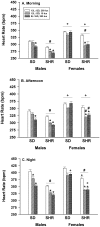

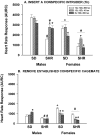
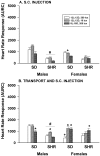
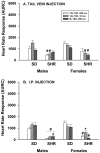
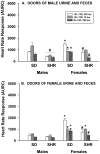
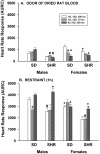
References
-
- Adams N, Lins MD, Blizard DA. 1987. Contrasting effects of social stress and foot-shock on acute cardiovascular response in salt-sensitive rats. Behav Neural Biol 48:368–381 - PubMed
-
- Aloisi AM, Steenbergen HL, van de Poll NE, Farabollini F. 1994. Sex-dependent effects of restraint on nociception and pituitary–adrenal hormones in the rat. Physiol Behav 55:789–793 - PubMed
-
- Amat J, Torres AR, Lechin F. 1993. Differential effect of footshock stress on humoral and cellular immune responses of the rat. Life Sci 53:315–322 - PubMed
-
- Azar T, Sharp J, Lawson D. 2005. Stress-like cardiovascular responses to common procedures in male versus female spontaneously hypertensive rats. Contemp Top Lab Anim Sci 44:25–30 - PubMed
-
- Bargiel Z, Nowicka H, Wojcikowska J. 1981. Swim-stress–induced changes of rat adrenal catecholamine level depending on metabolic state and different ambient temperature. Folia Histochem Cytochem (Krakow) 19:31–37 - PubMed
Publication types
MeSH terms
LinkOut - more resources
Full Text Sources
